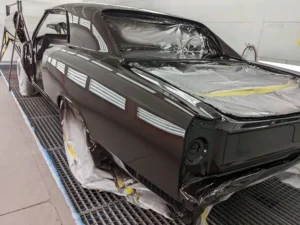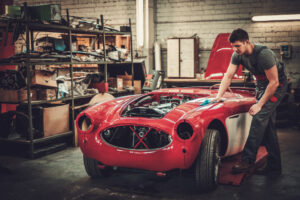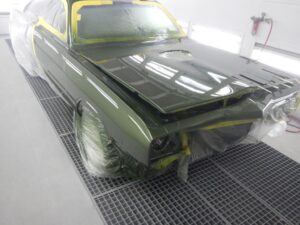Timeless Designs Reimagined: Auto Body Work and Automotive Restoration Near Me
Sheet Metal Art and Grit: The Wayback to Classic Cars
Turning grime-clad crusties to blinged-out bombshells is where artizan meets engineering meets insanity. Restoring auto body classic cars is a love job but a living jigsaw puzzle that even the parts can be out of existence and the shapes can never range to fit in the first place. It is not only the beauty of the vision, but the struggle, pain, and success of obtaining the right lines on all the curves.

Lightrust: The Uninvited Guest on Classic Metal
People have forgotten history, and rust does not respect it. It infiltrates itself within panels, crawls through cracks and on seams and corrodes sacred machines. Its traces appear on fenders, hoods and frames long before a wrench is turned. When left alone, it starts eating up the identity of the car. To restore a classic car, rust removal is a precondition, but further on the path is going to be much more complicated.
They normally pepper the original sheet metal with rust holes, reduce it to being thin or warp it into something unrecognizable. There is not always a panel replacement. Even when you get them, there is a chance that they will never look the same as the initial shape. That is where the magic really is, people who can cut, shape and weld panels literally out of a panel, such craftspeople. The methods employed by these metal mumble-junkies are something out of old factory floors: shrinking, stretching, hammering and (when the action demands it) gas-welding.
Panels- Not Just Skin Deep
There is no use beating around the bush: cars of our age nowadays are mass produced. Classic cars? Very frequently, every panel, curve and crease was created manually or in low-volume tooling. Today it is not so easy to reproduce these shapes by drawing lines on a blueprint.
English wheels, planishing hammers, and an eclectic collection of fun tools are what are used to lure steel and aluminum into those iconic shapes by the metal fabricators. You will get to see sometimes, they just visually stretching a fender, with just a wooden buck and gut on their side only. It is all about matching the contour. An eighth of an inch too much, and that formerly-elegant arch appears to have been pushed by a shopping cart. An old tradition among restorers asserts, that the eye rests where the metal rings.
The 1960s Jaguar E-Type is a good example, an example with voluptuous hips. When you mess the curve of a rear wing, the auto loses its feline slinkiness and just looks embarrassed–fated to sit at the tail-end of a show field. Enter example: ill-fitting lines were more of the news at the Pebble Beach than in the subpar refurbishing.

Welding The Welding Chronicles
The welding involved in classic car restoration is not the kind that you are taught in the shop class during high school. It is a sensitive task. Thin, soft metals require most projects to be done by gas welding or TIG welding. These connections must be almost unseen given that they are common to be exposed once the vehicle is completed. On high-ticket jobs metal may even be leaded, not simply stuffed with plastic body filler.
Dress-down and hand-file of welds are done. To have the right thickness and feathered edge hundreds of passes are required across the surface to be made. Any imperfection will be betrayed by the manner in which a light reflects down one of these panels which are newly worked. It is usually a process of numerous rounds of priming, blocking and reworking. And it is a marathon, not a sprint, you frequently will run into hundreds of labor hours before you even start the paint.
The Reality concerning the Fine Lines and Lines
They are purists going cuckoo about factory authenticity. They are able to tell a cheated door gap or non matching panel line across the lot that does not match the original blueprint. What is the obsession behind it?
The typical designs talk with their lines. Consider the Cadillac tailfin, the sweeping mound of the Porsche 356 or the swoop of its bonnets upon a Ferrari 250 GTO. The beauty of the lines was not the only thing. These were utterances. They ushered an era. Fabricated by these designers (their names were as wonderful as Bertone or Pininfarina) such lines and curves narrated the stories about speed, dream, and patriotic feelings.
When you digress these lines in a restoration you run the risk of effacing history. The automobile stops being a time capsule. Instead, you get left with a hollow – devoid of soul, like a copy devoid of soul. To the collectors, the difference between a show winner and a sideshow curiosity is the correct line. To the drivers, it is important also.
The Human Element Tools, Hands and Heritage
Stores of restoration garages are sounding. Old-timers are always around to remember when these vehicles were very new. Their lessons give apprentices a sense of metal–how it bends, where it buckles and what it takes to convince it again to go back into shape.

Any craftsman will tell you that there is the war story: the stinking crease that refused to work its way out, the patch panel that had to be “repatched” three times or the quarter panel that was pounded out under the starlight because the deadline was nighing. Such anecdotes become life-blood of the restoration world. They remind us that the greatest in the industry are only on the way to perfection; one hammer blow at a time.
Why Should All of This Matter?
Maintaining the craftsmanship of the traditional design is significant to the lovers of the art, history and anyone who develops that nostalgic feeling whenever a vintage motor roars. Having these cars original in every way possible means more than money or awards. It is the matter of respecting the lines which marked decades of dreams.






